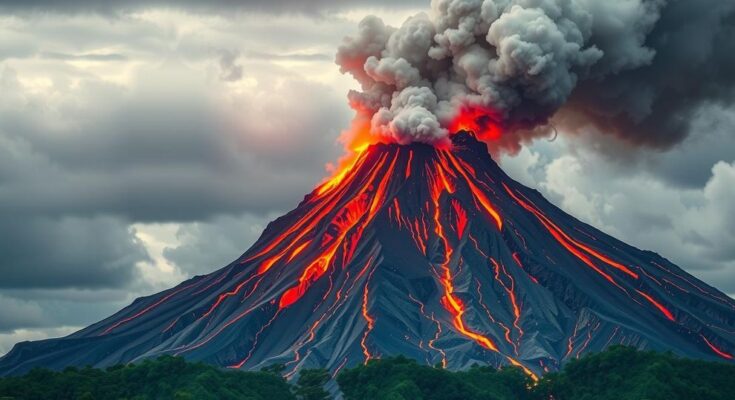On March 9, 2025, the Fuego volcano in Guatemala erupted, leading to the evacuation of nearly 900 residents from El Porvenir. An Orange Alert was issued by authorities due to elevated danger levels, triggering emergency responses and humanitarian aid mobilization. Health and agricultural concerns arose from ashfall, prompting advisories for safety and preparedness against lahar risks as volcanic activity continues.
On March 9, 2025, Guatemala’s Fuego volcano erupted, leading to the evacuation of nearly 900 individuals from El Porvenir in Alotenango. This response was coordinated by the National Coordinator for Disaster Reduction (CONRED), who reported that 125 families were relocated due to the volcano’s activity, which included temporary accommodations at the municipal hall.
The eruption, confirmed by the National Institute of Seismology, Volcanology, Meteorology, and Hydrology (INSIVUMEH), commenced at approximately 03:00 UTC, marking a significant resurgence of volcanic activity following a 49-day period of relative calm. Effusive eruptions persisted into March 10, sending incandescent ash fountains soaring upwards of 500 meters and generating columns of gas that reached altitudes of 6 kilometers.
During the eruption’s peak, pyroclastic flows surged through numerous ravines, while reports of explosive sounds likened to a train engine echoed within a considerable radius. The situation prompted authorities to issue an Orange Alert, indicating elevated danger and necessitating an immediate emergency response.
Guatemala has a systematic four-tier alert protocol, wherein the Orange Alert denotes high risk, mobilizing emergency response teams and facilitating evacuations. Local leadership engaged in critical emergency planning meetings to enhance coordination and aid for the affected population following the alert’s issuance.
In response to safety concerns, National Route 14 was closed and educational institutions in severely impacted municipalities were suspended. Ashfall was detected in San Miguel Pochuta, which raised apprehensions regarding respiratory health risks and potential agricultural disruptions.
Residents have been advised to heed official guidance, prepare essential emergency kits, and avoid certain areas susceptible to lahar hazards. The Guatemalan Volcanic Surveillance Observatory also emphasized cautionary measures for airborne tourism as ash dispersion could extend considerably due to seasonal winds.
As Fuego volcano continues to exhibit elevated activity, emergency services remain vigilant. With a height of 3,763 meters, Fuego is recognized as one of Central America’s most active volcanoes, having previously caused substantial fatalities in a 2018 eruption.
The recent eruption of Guatemala’s Fuego volcano necessitated the evacuation of nearly 900 residents, highlighting the ongoing risks associated with its activity. The implementation of an Orange Alert system facilitated organized emergency responses to safeguard the affected population. As volcanic hazards persist, adherence to safety recommendations remains crucial for mitigating risks in the region.
Original Source: watchers.news




